Tupelo, Mississippi
| Tupelo, Mississippi | |
|---|---|
| City | |
| City of Tupelo | |
.jpg) Main Street in Tupelo | |
| Motto(s): "All-America City" | |
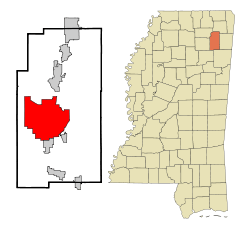 Location of Tupelo in Lee County | |
 Tupelo Location of Tupelo in the US | |
| Coordinates: 34°15′35″N 88°43′33″W / 34.25972°N 88.72583°WCoordinates: 34°15′35″N 88°43′33″W / 34.25972°N 88.72583°W | |
| Country |
|
| State |
|
| County | Lee |
| Districts | 1, 2, 3, 4, 5 |
| Incorporated | July 20, 1870 |
| Named for | Tupelo |
| Government[1] | |
| • Type | Mayor–Council |
| • Mayor | Jason Shelton (D) |
| • Council |
Members
|
| Area | |
| • City | 67.6 sq mi (133.2 km2) |
| • Land | 67.3 sq mi (132.4 km2) |
| • Water | 0.3 sq mi (0.8 km2) |
| Elevation | 279 ft (85 m) |
| Population (2010)[2] | |
| • City | 34,546 |
| • Estimate (2017)[3] | 38,114 |
| • Density | 510/sq mi (260/km2) |
| • Metro | 140,460 (US: 8th) |
| Time zone | UTC-6 (CST) |
| • Summer (DST) | UTC-5 (CDT) |
| ZIP code(s) | 38801, 38804, 38826, 38866 |
| Area code(s) | 662 |
| FIPS code | 28-74840 |
| GNIS feature ID | 678931 |
| Major airport | MEM |
| Website |
tupeloms |
Tupelo /ˈtuːpəloʊ/ is a city in, and county seat of, Lee County, Mississippi, United States. With an estimated population of 38,114 in 2017, Tupelo is the seventh-largest city in Mississippi and is considered a commercial, industrial, and cultural hub of North Mississippi.
Tupelo was incorporated in 1867, although the area had earlier been settled as "Gum Pond" along the Mobile and Ohio Railroad.[4] On February 7, 1934, Tupelo became the first city to receive power from the Tennessee Valley Authority thus giving it the nickname "The First TVA City."[5][6] Much of the city was devastated by a major tornado in 1936 that still ranks as one of the deadliest tornadoes in American history.[7] Following electrification, Tupelo boomed as a regional manufacturing and distribution center and was once considered a hub of the American furniture manufacturing industry.[8] Although many of Tupelo's manufacturing industries have declined since the 1990s, the city has continued to grow due to strong healthcare, retail, and financial service industries.
Tupelo has a deep connection to Mississippi's music history, being associated with artists as diverse as Elvis Presley, Rae Sremmurd, and Diplo. The city is home to multiple art and cultural institutions, including the Elvis Presley Birthplace and the 10,000-seat BancorpSouth Arena, the largest multipurpose indoor arena in Mississippi. Tupelo is the only city in the Southern United States to be named an All-America City five times, most recently in 2015.[9]
The Tupelo micropolitian area contains Lee, Itawamba, and Pontotoc counties and had a population of 140,081 in 2017.[10]
History
European colonization
Indigenous peoples lived in the area for thousands of years. The historic Chickasaw and Choctaw, both Muskogean-speaking peoples of the Southeast, occupied this area long before European encounter.
French and British colonists traded with these indigenous peoples and tried to make alliances with them. The French established towns in Mississippi mostly on the Gulf Coast. At times, the European powers came into armed conflict. On May 26, 1736, the Battle of Ackia was fought near the site of present-day Tupelo; British and Chickasaw soldiers repelled a French and Choctaw attack on the then-Chickasaw village of Ackia. The French, under Louisiana governor Jean Baptiste Le Moyne, Sieur de Bienville, had sought to link Louisiana with Acadia and the other northern colonies of New France.
In the early 19th century, after years of trading and encroachment by European-American settlers from the United States, conflicts increased as the US settlers tried to gain land from these nations. In 1830, Congress passed the Indian Removal Act and authorized the relocation of all the Southeast Native Americans west of the Mississippi River, which was completed by the end of the 1830s.
In the early years of settlement, European-Americans named this town Gum Pond, supposedly due to its numerous tupelo trees, known locally as blackgum. The city still hosts the annual Gumtree Arts Festival.
Civil War and post-war development
During the Civil War, Union and Confederate forces fought in the area in 1864 in the Battle of Tupelo. Designated the Tupelo National Battlefield, the battlefield is administered by the National Park Service (NPS). In addition, the Brices Cross Roads National Battlefield, about ten miles north, commemorates another American Civil War battle.
After the war, a cross-state railroad for northern Mississippi was constructed through the town, which encouraged industry and growth. With expansion, the town changed its name to Tupelo, in honor of the battle. It was incorporated in 1870.[11]
20th century to present
.jpg)
By the early twentieth century, the town had become a site of cotton textile mills, which provided new jobs for residents of the rural area. Under the state's segregation practices, the mills employed only white adults and children. Reformers documented the child workers and attempted to protect them through labor laws.[12]
The last known bank robbery by Machine Gun Kelly, a Prohibition-era gangster, took place on November 30, 1932 at the Citizen's State Bank in Tupelo; his gang netted $38,000. After the robbery, the bank's chief teller said of Kelly, "He was the kind of guy that, if you looked at him, you would never thought he was a bank robber."[13]
During the Great Depression, Tupelo was electrified by the new Tennessee Valley Authority, which had constructed dams and power plants throughout the region to generate hydroelectric power for the large, rural area. The distribution infrastructure was built with federal assistance as well, employing many local workers. In 1935, President Franklin Roosevelt visited this "First TVA City".
In 2007, the nearby village of Blue Springs was selected as the site for Toyota's eleventh automobile manufacturing plant in the United States.
In 2013 Gale Stauffer of the Tupelo Police Department died in a shootout following a bank robbery, possibly the first officer killed in the line of duty in the Department's history.[14]
Severe weather
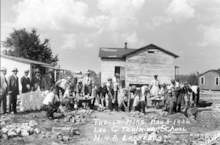
The spring of 1936 brought Tupelo one of its worst-ever natural disasters, part of the Tupelo-Gainesville tornado outbreak of April 5–6 in that year.[15] The storm leveled 48 city blocks and over 200 homes, killing 216 people and injuring more than 700 persons.[16] It struck at night, destroying large residential areas on the city's north side. Among the survivors was Elvis Presley, then a baby. Obliterating the Gum Pond neighborhood, the tornado dropped most of the victims' bodies in the pond. The storm has since been rated F5 on the modern Fujita scale.[17] The Tupelo Tornado is recognized as one of the deadliest in U.S. history.[18]
The Mississippi State Geologist estimated a final death toll of 233 persons, but 100 whites were still reported as hospitalized at the time. Because the white newspapers did not publish news about blacks until the 1940s and 1950s, historians have had difficulty learning the fates of blacks injured in the tornado. Based on this, historians now estimate the death toll was higher than in official records.[16][19] Fire broke out at the segregated Lee County Training School, which was destroyed. Its bricks were salvaged for other uses.
The area is subject to tornadoes. In 2008 one rated an EF3 on the Enhanced Fujita Scale struck the town. On April 28, 2014, a large tornado struck Tupelo and the surrounding communities, causing significant damage.
Geography and climate
Tupelo is located in northeast Mississippi, north of Columbus, on future Interstate 22 and U.S. Route 78, midway between Memphis, Tennessee (northwest) and Birmingham, Alabama (southeast).
According to the United States Census Bureau, the city has a total area of 51.4 square miles (133 km2), of which 51.1 square miles (132 km2) is land and 0.3 square miles (0.78 km2) (0.62%) is water.
Like the rest of the state, Tupelo has a humid subtropical climate (Cfa in the Köppen climate classification); it is part of USDA hardiness zone 7b.[20] The normal monthly mean temperature ranges from 41.7 °F (5.4 °C) in January to 81.4 °F (27.4 °C) in July, while, on average, there are 3.0 days where the temperature stays at or below freezing, 55 days with a low at or below freezing, and 67 days with a high at or above 90 °F (32 °C) per year.[21] The all-time record low is −14 °F (−26 °C), set on January 27, 1940, while the all-time record high is 109 °F (43 °C), set on July 29, 1930.[21] However, temperatures at or below 0 °F (−18 °C) are rare, having last occurred December 23, 1989, the date of the all-time record low for December; additionally, while highs can reach 100 °F (38 °C) several days a row during severe heat waves, several years may pass between such readings.[21]
Precipitation is high, averaging 55.0 inches (1,400 mm) annually. On average, December is the single wettest month, with wet conditions typical from late fall to late spring most years. On average, August and September are the driest months. The rainiest calendar day on record is March 21, 1955 when 9.40 inches (239 mm) of rain fell; monthly precipitation has ranged from trace amounts in August 1983 to 19.89 inches (505 mm) in December 1982.[21] Snow is uncommon, with many years receiving trace amounts or no snowfall at all, and normal (1981–2010) winter snowfall stands at 2.1 inches (5.3 cm).[21] The most snow in one calendar day was 8.0 inches (20 cm) on January 24, 1940, contributing to the 9.2 inches (23 cm) that fell that month, the snowiest on record; the snowiest winter was 1935–36 with 14.8 inches (38 cm).[21]
| Climate data for Tupelo Regional Airport, Mississippi (1981–2010 normals,[lower-alpha 1] extremes 1930–present) | |||||||||||||
|---|---|---|---|---|---|---|---|---|---|---|---|---|---|
| Month | Jan | Feb | Mar | Apr | May | Jun | Jul | Aug | Sep | Oct | Nov | Dec | Year |
| Record high °F (°C) | 80 (27) |
84 (29) |
89 (32) |
93 (34) |
100 (38) |
108 (42) |
109 (43) |
108 (42) |
104 (40) |
96 (36) |
88 (31) |
81 (27) |
109 (43) |
| Mean maximum °F (°C) | 69.9 (21.1) |
74.7 (23.7) |
81.3 (27.4) |
86.1 (30.1) |
90.6 (32.6) |
95.4 (35.2) |
97.7 (36.5) |
98.1 (36.7) |
94.5 (34.7) |
87.5 (30.8) |
79.5 (26.4) |
71.0 (21.7) |
99.5 (37.5) |
| Average high °F (°C) | 51.7 (10.9) |
56.6 (13.7) |
65.5 (18.6) |
74.1 (23.4) |
81.8 (27.7) |
88.7 (31.5) |
91.7 (33.2) |
91.5 (33.1) |
85.5 (29.7) |
75.3 (24.1) |
64.1 (17.8) |
53.8 (12.1) |
73.4 (23) |
| Average low °F (°C) | 31.7 (−0.2) |
35.3 (1.8) |
42.5 (5.8) |
50.2 (10.1) |
59.6 (15.3) |
67.6 (19.8) |
71.2 (21.8) |
70.1 (21.2) |
62.8 (17.1) |
50.8 (10.4) |
41.7 (5.4) |
34.3 (1.3) |
51.5 (10.8) |
| Mean minimum °F (°C) | 14.2 (−9.9) |
18.3 (−7.6) |
25.8 (−3.4) |
33.7 (0.9) |
45.4 (7.4) |
56.0 (13.3) |
62.5 (16.9) |
61.3 (16.3) |
46.8 (8.2) |
34.5 (1.4) |
25.7 (−3.5) |
17.3 (−8.2) |
11.6 (−11.3) |
| Record low °F (°C) | −14 (−26) |
−3 (−19) |
7 (−14) |
23 (−5) |
30 (−1) |
43 (6) |
50 (10) |
51 (11) |
35 (2) |
24 (−4) |
8 (−13) |
−3 (−19) |
−14 (−26) |
| Average precipitation inches (mm) | 4.48 (113.8) |
4.96 (126) |
4.82 (122.4) |
4.78 (121.4) |
5.56 (141.2) |
4.52 (114.8) |
3.90 (99.1) |
3.45 (87.6) |
3.44 (87.4) |
4.12 (104.6) |
4.70 (119.4) |
6.28 (159.5) |
55.01 (1,397.2) |
| Average snowfall inches (cm) | 0.9 (2.3) |
0.6 (1.5) |
0.3 (0.8) |
0 (0) |
0 (0) |
0 (0) |
0 (0) |
0 (0) |
0 (0) |
0 (0) |
0.0 (0) |
0.3 (0.8) |
2.1 (5.4) |
| Average precipitation days (≥ 0.01 in) | 10.0 | 10.1 | 10.1 | 9.5 | 10.6 | 9.8 | 9.0 | 7.5 | 6.5 | 7.6 | 9.0 | 10.6 | 110.3 |
| Average snowy days (≥ 0.1 in) | 0.9 | 0.7 | 0.3 | 0 | 0 | 0 | 0 | 0 | 0 | 0 | 0 | 0.5 | 2.4 |
| Source: NOAA[21][22] | |||||||||||||
Demographics
| Historical population | |||
|---|---|---|---|
| Census | Pop. | %± | |
| 1870 | 618 | — | |
| 1880 | 1,008 | 63.1% | |
| 1890 | 1,477 | 46.5% | |
| 1900 | 2,118 | 43.4% | |
| 1910 | 3,881 | 83.2% | |
| 1920 | 5,055 | 30.2% | |
| 1930 | 6,361 | 25.8% | |
| 1940 | 8,212 | 29.1% | |
| 1950 | 11,527 | 40.4% | |
| 1960 | 17,221 | 49.4% | |
| 1970 | 20,471 | 18.9% | |
| 1980 | 23,905 | 16.8% | |
| 1990 | 30,685 | 28.4% | |
| 2000 | 34,211 | 11.5% | |
| 2010 | 34,546 | 1.0% | |
| Est. 2017 | 38,114 | [3] | 10.3% |
| U.S. Decennial Census[23] 2013 Estimate[24] | |||
As of the census of 2010, there are 35,456 people, 13,602 households, and 8,965 families residing in the city. The racial makeup of the city is 58.7% White, 36.8% African American, 0.1% Native American, 1.0% Asian, 0.01% Pacific Islander, 2.0% from other races, and 1.4% from two or more races. 3.5% of the population are Hispanic or Latino of any race.[2]
According to the 2007–2011 American Community Survey 5-Year Estimates, there are 13,395 households, 42.8% are married couples living together, 2.6% have a male householder with no wife present, and 22.5% have a female householder with no husband present. 32.2% are non-family households, with 28.4% have a householder living alone and 3.8% having a householder not living alone. In addition, 39.7% of householders are living with related children under 18 and 60.3% with no related children under 18.[25] The average household size is 2.47 and the average family size is 3.08.[2]
The median income for a household in the city is $39,415. The poverty rate for people living below the poverty line is 20%.[2]
Economy
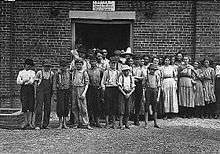
Historically, Tupelo served as a regional transportation hub, primarily due to its location at a railroad intersection. More recently, it has developed as strong tourism and hospitality sector based around the Elvis Presley birthplace and Natchez Trace. The city has also been successful at attracting manufacturing, retail and distribution operations (see 'Industry' section below).[26]
Industry
- Tupelo is the headquarters of the North Mississippi Medical Center, the largest non-metropolitan hospital in the United States. It serves people in North Mississippi, northwest Alabama and portions of Tennessee. The medical center was a winner of the prestigious Malcolm Baldrige National Quality Award in 2006 and 2012.
- The headquarters of two banking institutions are located here: BancorpSouth, with approximately $11.8 billion in assets (2006), and Renasant, with assets of approximately $11 billion (2018).
- The city is a five-time "All-America City Award" winner.
- In 1963, Ralph J. Roberts, along with Daniel Aaron and Julian A. Brodsky purchased American Cable Systems, a small cable operator in Tupelo. American Cable was re-incorporated in Pennsylvania as Comcast
- It has a large furniture manufacturing industry. The journalist Dennis Seid noted that furniture manufacturing in Northeast Mississippi, "provid[ed] some 22,000 jobs, or almost 13% of the region's employment... with a $732 million annual payroll... producing $2.25 billion worth of goods."[27]
- Tecumseh, Heritage Home Group, Hancock Fabrics, Inc., Magnolia Fabrics, Toyota Motor Manufacturing Mississippi, H.M. Richards, JESCO Construction, MTD Products, Savings Oil Company (Dodge's Stores), and Cooper Tire & Rubber Company all operate or are headquartered in Tupelo and Lee County. Renin Corporation, a subsidiary of BBX Capital Corporation, operates a production centre in Tupelo which employed 50 but an expansion in 2017 expected to increase staffing to 100.[28]
Arts and culture
- The Tupelo Buffalo Park and Zoo is home to hundreds of animals and a large American bison herd.
- It is the headquarters of the historic Natchez Trace Parkway, which connects Natchez, Mississippi, to Nashville, Tennessee. The parkway follows the route of the ancient Natchez Trace trail, a path used by indigenous peoples long before the Europeans came to the area.[29]
- Nearby are the Pharr Mounds, an important Middle Woodland period complex of nearly 2000-year-old burial earthworks, dating from 1 to 200 AD.[30]
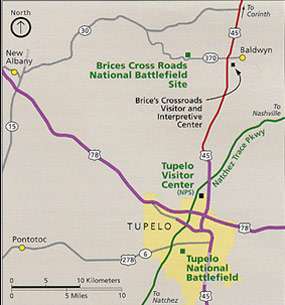
- Civil War sites include Tupelo and Brices Cross Roads national battlefields.
- The Tupelo Automobile Museum is one of the largest of this type in North America.[29] In 2003, it was designated as the official automobile museum of the state. It houses more than 150 rare automobiles, all from the personal collection of Frank K. Spain, who founded the channel WTVA.
- Since its founding in 1969, the Tupelo Community Theatre has produced more than 200 works. In 2001 and 2004, it won awards at the Mississippi Theatre Association's Community Theatre festival. In 2004 its production of Bel Canto won at the Southeastern Theatre Conference. TCT's home is the historic Lyric Theatre, built in 1912.[31]
- The Tupelo Symphony Orchestra's season runs from September–April with concerts held at the Tupelo Civic Auditorium.[32] The symphony's free annual July 4 outdoor concert at Ballard Park draws thousands of fans.
- In 2005, the Rotary Club sponsored a commission for a statue to honor Chief Piomingo, a leader of the Chickasaw people who had occupied this area. It was erected in front of the new Tupelo City Hall.
- The Oren Dunn City Museum tells the Story of Community Building through permanent exhibits and a collection of historic structures. The Special Exhibit Gallery provides a venue for a variety of traveling and temporary shows throughout the year.
- In June 1956 noted singer Elvis Presley returned to Tupelo for a concert at the Mississippi-Alabama State Fair & Dairy Show. This event was recreated at the eighth "Elvis Presley Festival" in Tupelo on June 3, 2006. The fairgrounds is part of Tupelo's Fairpark District. The documentary film, The Homecoming: Tupelo Welcomes Elvis Home, premiered at the 2006 festival.
- Tupelo is serviced by the Lee-Itawamba Library System. The Lee County Library, located in downtown Tupelo, has an annual lecture series featuring nationally known authors. In addition to the annual lecture series, the Lee County Library features a Mississippi room dedicated to genealogy research.
- Built in 1937, the Church Street Elementary School (for white students in the segregated system) was hailed as one of the most outstanding designs of its time. A scale model of this Art Moderne structure, described as "the ideal elementary school," was displayed at the 1939 New York World's Fair.
- The BancorpSouth Arena opened in 1993 and is a venue for large events.[32]
Government
Tupelo's current mayor is Jason L. Shelton. The Tupelo Council is made up of seven representatives, each elected from single-member districts. They annually elect the president of the council on a rotating basis. In 2017, the President of the Tupelo City Council is Lynn Bryan. Other council members are Markel Whittington, Buddy Palmer, Willie Jennings, Mike Bryan and Nettie Davis.[33]
Jim Newell was elected to the City Council in 2013, but resigned August 1, 2014, when he moved out of the ward he represented. A special election was held to fill the vacancy is set for September 4, 2014.[34][35]
In 2013 Nettie Davis was elected by the council as President, becoming the first woman and first African American to hold the position. Davis has served on the council for four terms.[36]
Mayor Jason Shelton sought re-election in 2017 and was returned to office for another four years in the Democratic Primary by garnering 85.55 percent of the votes cast. His opponent was Candace Knowles.
Mayor Jack Reed did not seek reelection in 2013. Attorney Jason Shelton, a Democrat, was elected mayor on June 4, 2013, over council chairman Fred Pitts, a Republican.[37]
The city government has been honored with many awards in 2015, including: ° All-America City, National League of Cities (5th designation) [38] ° Mississippi Municipal League Award of Excellence[39] ° Southern Public Relations Federation Certificate of Merit, Tupelo Convention and Visitors Bureau [40] ° Southern Public Relations Federation Award of Excellence, Tupelo Convention and Visitors Bureau [40] ° Southern Public Relations Lantern Award (2), Tupelo Convention and Visitors Bureau [40] ° Mississippi Governor's Conference on Tourism Volunteer of the Year, Bev Crossen nominated by Tupelo Convention and Visitors Bureau [40] ° Mississippi Governor's Conference on Tourism Large Festival/Event Award, Tupelo Convention and Visitors Bureau [40] ° Mississippi Governor's Conference on Tourism Travel Media Award, Tupelo Convention and Visitors Bureau [40] ° Mississippi Urban Forest Council Lifetime Achievement David Knight [41] ° Mississippi Urban Forest Council 2015 Scenic Community Award [42] ° Mississippi Recreation and Parks Association Design Award, Joyner Splash Pad [43] ° Mississippi Recreation and Parks Association Award of Excellence in Special Events Sports Programing, Southern Zone Age Group Swimming Championship, The Tupelo Aquatic Center [43]
Education
Tupelo schools are served by the Tupelo Public School District. It participates in the Chromebook Distribution Policy, which means students in grades 6-12 are each given a school-owned Google Chromebook to use during the school year. In 2008, Sports Illustrated ranked the high school athletic department as the third-best high school athletic program in the nation.[44]
For post-secondary education, the city has satellite campuses of the University of Mississippi, Itawamba Community College, and the Mississippi University for Women.
Media
The local daily newspaper is the Northeast Mississippi Daily Journal.
Tupelo is home to three television stations serving the 133rd-ranked designated market area among 210 markets nationwide as determined by Nielsen Media Research: WTVA (9), an NBC and ABC affiliate; and WLOV (27), a Fox affiliate. Both stations are located on Beech Springs Road and were controlled by Frank K. Spain until his death on April 25, 2006.
The American Family Association, located in Tupelo, includes the national American Family Radio network and the OneNewsNow news service.
Notable people

- Alex Carrington (born 1987), American football player
- Dave Clark (born 1962), American baseball player and coach
- Diplo (born 1978), American musical artist
- Brian Dozier (born 1987), American baseball player
- Todd Jordan (born 1970), American football player
- John Murry (born 1979), American singer-songwriter
- Elvis Presley (1935–1977), American singer and actor
- Chris Stratton (born 1990), American baseball player
- Roger Wicker (born 1951), Senator
- Swae Lee, hip-hop artist and member of Rae Sremmurd
- Slim Jxmmi, hip-hop artist and member of Rae Sremmurd
See also
References
- ↑ Mean monthly maxima and minima (i.e. the expected highest and lowest temperature readings at any point during the year or given month) calculated based on data at said location from 1981 to 2010.
- ↑ "Tupelo, Mississippi". City of Tupelo. 2014. Retrieved May 12, 2017.
- 1 2 3 4 "2010 Census Redistricting Data (Public Law 94-171) Summary File". American FactFinder. United States Census Bureau. Archived from the original on 21 July 2011. Retrieved 22 March 2012.
- 1 2 "Population and Housing Unit Estimates". Retrieved June 9, 2017.
- ↑ "Tupelo | Mississippi, United States". Encyclopedia Britannica. Retrieved 2018-07-05.
- ↑ "The Rural Electrification of Northeast Mississippi". Sara E. Morris. Mississippi History Now. Retrieved 2017-03-29.
- ↑ "The Role of Publicly Provided Electricity in Economic Development: The Experience of the Tennessee Valley Authority 1929-1955" (PDF). Carl T. Kitchens. 2012. Retrieved 2017-03-29.
- ↑ "25 Deadliest U.S. Tornadoes". www.spc.noaa.gov. Retrieved 2018-07-05.
- ↑ "Mississippi: Crafting a Comeback: Mississippi's furniture industry is rebounding as tax credits encourage investment. | Site Selection Online". Site Selection. Retrieved 2018-07-05.
- ↑ Guajardo, Rod. "Tupelo: All-America City again". Daily Journal. Retrieved 2018-07-05.
- ↑ Bureau, US Census. "Metropolitan and Micropolitan Statistical Areas Totals: 2010-2017". www.census.gov. Retrieved 2018-07-05.
- ↑ Dale Cox (1935-01-08). "Tupelo, Mississippi - Historic Sites and Points of Interest". Exploresouthernhistory.com. Retrieved 2013-07-02.
- ↑ "Tupelo, MS". GumTree Chronicles. Retrieved 2013-07-02.
- ↑ "George "Machine Gun" Kelly: American Robber and Kidnapper". crimelibrary. July 18, 2007. Archived from the original on February 4, 2008. Retrieved November 7, 2007.
- ↑ Capeloutoaccess, Susanna (December 29, 2013). "Phoenix police fatally shoot man suspected in multi-state robberies, cop killing". CNN.
- ↑ "Tupelo-Gainesville Outbreak", Digital Library of Georgia, 2008, retrieved 12 Sept 2011
- 1 2 "Significant Tornadoes Update 1992–1995" Archived May 20, 2013, at the Wayback Machine., Mid-South Tornadoes, Mississippi State University
- ↑ "This Day In History; Tornadoes Devastate Tupelo and Gainesville", The History Channel online, retrieved 13 September 2011
- ↑ "The 10 deadliest U.S. tornadoes on record". CNN.com. Retrieved 2013-07-02.
- ↑ Martis D. Ramage, Jr. Tupelo, Mississippi, Tornado of 1936,
- ↑ United States Department of Agriculture. United States National Arboretum. USDA Plant Hardiness Zone Map [archived March 3, 2015; Retrieved 2015-03-02].
- 1 2 3 4 5 6 7 "NowData - NOAA Online Weather Data". National Oceanic and Atmospheric Administration. Retrieved 2018-01-15.
- ↑ "Station Name: MS TUPELO RGNL AP". National Oceanic and Atmospheric Administration. Retrieved 2015-03-02.
- ↑ United States Census Bureau. "Census of Population and Housing". Archived from the original on May 12, 2015. Retrieved November 8, 2014.
- ↑ "Population Estimates". United States Census Bureau. Retrieved 2014-11-08.
- ↑ "Community Facts: Tupelo city". Retrieved March 15, 2014.
- ↑ "About Tupelo | City of Tupelo". Tupeloms.gov. Archived from the original on March 14, 2012. Retrieved March 25, 2012.
- ↑ Dennis Seid, The Northeast Mississippi Business Journal, February 2006
- ↑ http://www.areadevelopment.com/newsItems/5-26-2017/renin-corporation-manufacturing-plant-tupelo-mississippi.shtml
- 1 2 "About the City of Tupelo" (2006), City of Tupelo website, web: TupeloMS-About Archived March 14, 2012, at the Wayback Machine.: for Elvis, the Natchez Trace Parkway, and Tupelo Automobile Museum.
- ↑ "Pharr Mounds-National Register of Historic Places Indian Mounds of Mississippi Travel Itinerary". National Park Service. Retrieved 2010-11-16.
- ↑ Tom Wicker. "Lyric History". Tctwebstage.com. Retrieved 2013-07-02.
- 1 2 "City of Tupelo - Attractions", 2006, City of Tupelo website
- ↑ Tupelo City Council
- ↑ "Archived copy". Archived from the original on 2014-08-20. Retrieved 2014-08-19.
- ↑ "Archived copy". Archived from the original on 2014-08-20. Retrieved 2014-08-19.
- ↑ , Lee County Courier, 13 February 2014
- ↑ "Jason Shelton wins big: Tupelo elects 37-year-old mayor", NE Mississippi Daily Journal
- ↑ Rod Guajardo (2015-06-15). "Tupelo: All-America City again - Daily Journal". Djournal.com. Retrieved 2016-07-28.
- ↑ Rod Guajardo (2015-06-25). "Tupelo receives top municipal honor - Daily Journal". Djournal.com. Retrieved 2016-07-28.
- 1 2 3 4 5 6 Zack Orsborn (2015-10-01). "Tupelo CVB earns several awards - Daily Journal". Djournal.com. Retrieved 2016-07-28.
- ↑ "City of Tupelo - Mayor's Office - Timeline". Facebook. Retrieved 2016-07-28.
- ↑ Daily Journal (2015-08-23). "OUR OPINION: Stay steady on plan for reforesting Tupelo - Daily Journal". Djournal.com. Retrieved 2016-07-28.
- 1 2 William Moore (2015-09-29). "Tupelo Parks & Recreation brings home awards - Daily Journal". Djournal.com. Retrieved 2016-07-28.
- ↑ "Top 25 athletic programs for 2007-08". Sportsillustrated.cnn.com. Retrieved 2013-07-02.
External links
- Government
- General information

- Lee – Itawamba Library System at SirsiDynix
- Tupelo Convention & Visitors Bureau
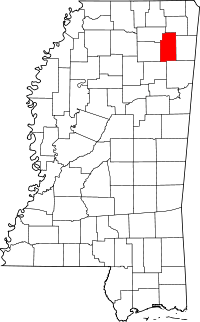
.svg.png)